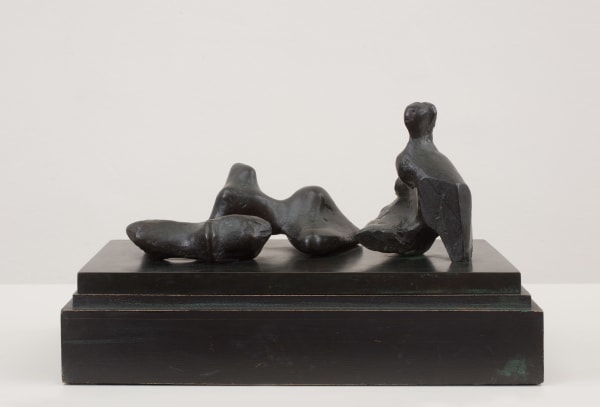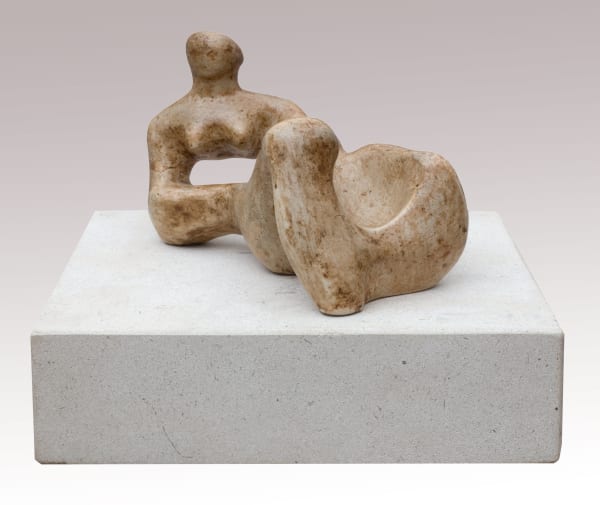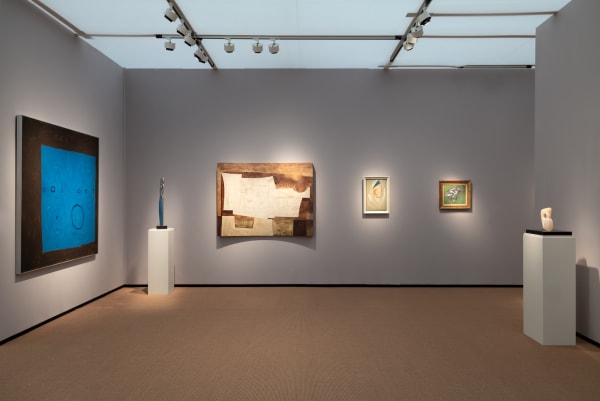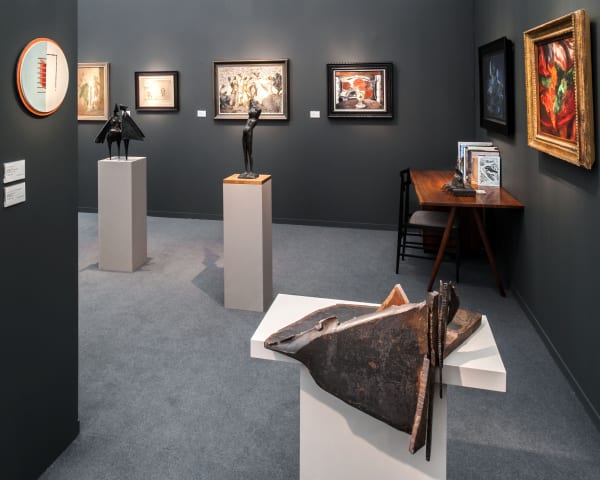Henry Moore
The gallery regularly handles, acquires and advises on works by Henry Moore. For more information or the availability of work, please contact the gallery.
Henry Moore (1898–1986)
The son of a Yorkshire coal-mining engineer, Henry Moore studied at Leeds School of Art in 1919, after war service in France. In 1921 he won a scholarship to the Royal College, London, where, in addition to his studies, he spent much time in the British Museum. An enthusiastic Modernist, Moore kept in touch with European developments and admired the work of the British sculptors Epstein, Gaudier-Brzeska, and Gill. From 1925 to 1931 he taught at the Royal College during which time, in 1928, he received his first commission, a relief for the London Underground Headquarters which proved controversial because of its 'Primitivism'.
His work of this period, like the Reclining Figure (1929; Leeds, AG) shows the influence of Epstein and 'primitive' Mayan art. During the 1930s Moore was associated with the Hampstead artists, particularly Nicholson and Hepworth whom he joined in the 7&5 Society in 1930 and Unit One in 1933, and moved to Chelsea School of Art (1932-9) which he found more progressive than the Royal College. The abstract biomorphic carvings of this period, including Family (1935; Henry Moore Foundation) and Square Form (1936; Norwich, Sainsbury Centre), are among his most innovative works and, in common with Hepworth, he also explored the potential of the pierced form, a stylistic device which was to bring him notoriety, in the 1930s.
In 1940, through the diplomacy of Kenneth Clark, Moore was commissioned as a war artist and his drawings of sleepers in the Underground during the Blitz are among the most moving records of the Home Front. During the 1940s he established an international reputation which was confirmed by the award of the International Sculpture Prize at the Venice Biennale of 1948. During the 1950s monumental reclining female figures, of varying degrees of abstraction, dominated his work, culminating in the Reclining Figure carved for the UNESCO building, Paris, in 1957. He also produced increasing numbers of modelled and cast figures and through the 1960s experimented with sculptures in several parts, creating tension between the individual elements, as in Double Figure (London, outside Westminster Cathedral). Moore's output, from the 1960s until his death, was enormous and entailed the employment of many studio assistants; public and corporate commissions were matched by the sale of small maquettes, in limited editions, to satisfy individual collectors.
There is no doubt of his stature and significance in 20th-century sculpture. Determinedly humanist, even at his most abstract, his forms evolved to chart human awareness and anxieties in a changing world. Vitality was the quality in sculpture that for him defined success or failure, a force unrelated to traditional concepts of beauty, revealed through the energy contained within the work.
The Oxford Companion to Western Art
-
 Ideas for Upright Internal/External Forms, 1939-40, c.
Ideas for Upright Internal/External Forms, 1939-40, c. -
 Time/Life Screen: Maquette No. 4, 1952 / cast 1952
Time/Life Screen: Maquette No. 4, 1952 / cast 1952 -
 Mother and Child, 1956 (cast 1965)
Mother and Child, 1956 (cast 1965) -
 Three Piece Reclining Figure: Maquette No.5, 1977 / cast 1977
Three Piece Reclining Figure: Maquette No.5, 1977 / cast 1977 -
 Reclining Figure, conceived 1936-37
Reclining Figure, conceived 1936-37 -
 Ideas for Sculpture: Reclining Figures, 1934/1954, c.
Ideas for Sculpture: Reclining Figures, 1934/1954, c. -
 Maquette for 'Recumbent Figure', 1938
Maquette for 'Recumbent Figure', 1938 -
 Seated Woman, 1959
Seated Woman, 1959 -
 Sheep Drawing, 1972
Sheep Drawing, 1972
-

Frieze Masters
Regents Park, London 15 - 19 Oct 2025 Art FairPiano Nobile are exhibiting at Frieze Masters. Our curated display illustrates key episodes in British art of the last century. Highlights include a significant alabaster sculpture by Barbara Hepworth, works...Read more -

Treasure House Fair
Royal Hospital Chelsea 27 Jun - 2 Jul 2024 Art FairPiano Nobile returned to The Treasure House Fair in June of 2024. We highlighted works from across the twentieth century, with early paintings by Augustus John and Walter Sickert, Duncan...Read more -

Treasure House Fair
Royal Hospital Chelsea 22 - 26 Jun 2023 Art FairThe Treasure House Fair is a celebration of outstanding and rare art and antiques. Held at The Royal Hospital Chelsea the fair continues the tradition of its predecessors, Masterpiece and...Read more -

Drawn to Paper
Giacometti to Hockney 16 Mar - 12 May 2023 Piano NobileSince the Renaissance, blank sheets of paper have been an important creative motor in Western art. They provide a neutral space, ideally suited for both effortless jeux d’esprit and hard-won...Read more -

Masterpiece
Royal Hospital Chelsea 30 Jun - 6 Jul 2022 Art FairPiano Nobile exhibited at Masterpiece Art Fair in 2022, then London's leading art and antiques fair. Highlights from the gallery's stand included significant works by Walter Sickert, Henry Moore, Paul...Read more -

Drawn to Paper
Degas to Rego 24 Jun - 24 Jul 2020In 2020 Piano Nobile presented Drawn to Paper: Degas to Rego , an online exhibition which showcased works on paper by some of the leading figures of European modernism. The...Read more -

Masterpiece
Royal Hospital Chelsea 27 Jun - 5 Jul 2017 Art FairThe gallery presented a selection of Modern and Contemporary British and International artists including works by William Scott, Tracey Emin, Lucian Freud, Augustus John, Duncan Grant and Vanessa Bell, Eduardo...Read more -

Masterpiece
Royal Hospital Chelsea 28 Jun - 6 Jul 2016 Art FairPiano Nobile returns to Masterpiece for 2016 with Modern British, International and Contemporary art for sale.Read more
-

InSight No. 169
Henry Moore | Three Piece Reclining Figure Maquette No. 5 April 11, 2025Henry Moore used fragmented forms to reimagine the human figure in two and three ‘piece’ sculptures. They related to a long history of antique remains...Read more -

InSight No. 149
Henry Moore | Time/Life Screen: Maquette No. 4 May 24, 2024Rising to the challenge of antiquity and throwing off the restrictions of wartime austerity, Henry Moore gave a distinctive face to the luxurious office building...Read more -

InSight No. 143
Henry Moore | Ideas for Sculpture: Reclining Figures February 16, 2024Like Leonardo, Raphael and Michelangelo before him, Henry Moore was a doodler. He liked to doodle and he doodled with the best of them. InSight...Read more -

InSight No. 123
Henry Moore | Seated Woman April 21, 2023The drawings of Henry Moore convey a sense of three dimensions in two, often equalling or even surpassing the substance and gravitas of the artist’s...Read more -

London Art Fair 2017
The Islington Tribune January 17, 2017Ahead of the London Art Fair 2017, The Islington Tribune featured Piano Nobile as a fair highlight in their coverage for the Arts section of...Read more


























